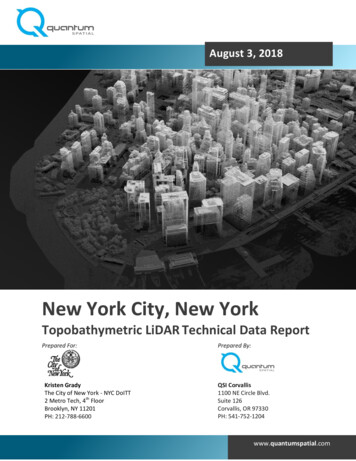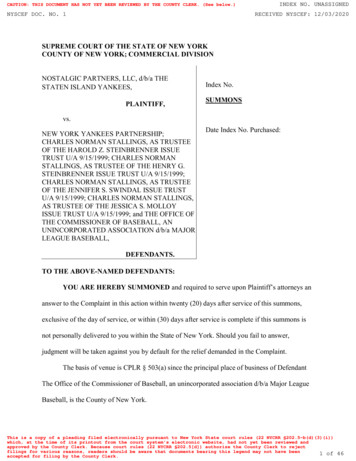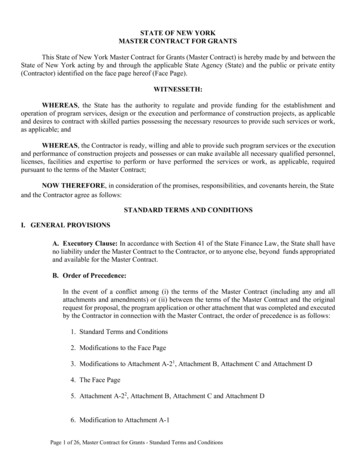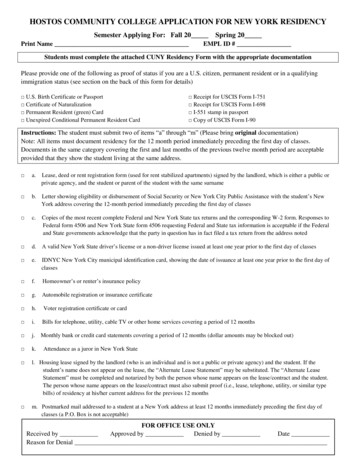
Transcription
New York State Report on Quality,Patient Safety, and EfficiencyDivision of Information and StatisticsOffice of Quality and Patient SafetyOctober 20162014
Page Intentionally Left Blank
IntroductionWelcome to the first version of the New York State Report on Quality, Patient Safety, and Efficiency prepared by theDivision of Information and Statistics within the New York State Department of Health Office of Quality and PatientSafety. This report contains the most up to date quality, patient safety, and efficiency measures, using New York Stateall payer inpatient discharges and treat and release emergency room visits collected as part of the Statewide Planningand Research Cooperative System (SPARCS).This report is laid out in two main sections: Section 1: Community Measures; and Section 2: Hospital Measures.MEASURESThe quality, patient safety, and efficiency metrics contained within this report are calculated using Agency for HealthCare Research and Quality (AHRQ) and 3M Health Information System performance measures. Contained within eachsection of the report (and in the Technical Appendix) is additional information on the technical specifications andsoftware used to produce the metrics presented.What measures are in this report?Community MeasuresAHRQ Pediatric Quality Indicators (PDIs)AHRQ Prevention Quality Indicators (PQIs)3M Potentially Preventable Emergency Room Visits (PPVs)Hospital MeasuresAHRQ Inpatient Quality Indicators (IQIs)AHRQ Patient Safety Indicators (PSIs)3M Potentially Preventable Complications (PPCs)3M Potentially Preventable Readmissions (PPRs)DATA RESOURCESThe Statewide Planning and Research Cooperative System (SPARCS) is a comprehensive all payer data systemestablished in 1979 as a result of cooperation between the healthcare industry and government. SPARCS collectsinpatient and outpatient data from all Article 28 facilities operating in New York State. SPARCS is one of the largesthospital discharge data systems in the country with over 2.3 million inpatient discharges and 6.7 million treat andrelease (i.e., same day) emergency room visits during 2014. For more information on SPARCS, including StatisticalBriefs, visit the SPARCS page on the DOH website at the following address: chers interested in longitudinal data files of inpatient discharges and selected performance metrics, can find themavailable for download on the Open NY data portal for health data – Health Data NY https://health.data.ny.gov/.Hospital Quality metrics are also presented for consumers on the NYS Health Profiles website:http://profiles.health.ny.gov/.We welcome feedback on this report. Please contact us at:Division of Information and StatisticsOffice of Quality and Patient SafetyNew York State Department of HealthCorning Tower, Room 1911Albany, New York 12237Phone: (518) 474-3189Email: sparcs.submissions@health.ny.gov
ContentsIntroduction . iiExecutive Summary . 1Summary of Findings . 2Section I: Community Measures . 5AHRQ Pediatric Quality Indicators (PDI) .5Table 1: PDI Rates per 100,000 Population with National Benchmark, 2013-2014 . 6Table 2: PDI Discharges and Statewide Rates per 100,000 Population with National Benchmark, 2014 . 6Table 3: PDI Mean Cost per Discharge, Median Cost per Discharge, and Average Length of Stay (ALOS), 2014 . 6Table 4: PDI Mean Cost per Discharge, Median Cost per Discharge, and Average Length of Stay (ALOS) by Age Group, 2014 . 7Table 5: PDI Age-Sex-Race/Ethnicity Adjusted Rates per 100,000 Population by Patient County, 2014 . 8Table 6: PDI Observed Rates per 100,000 Population, and Observed to Expected Ratios, by Region, 2013-2014 . 10Table 7: PDI Rates per 100,000 Population by Gender with Ranking, 2014 . 12Table 8: PDI Rates per 100,000 Population by Age Group with Ranking, 2014 . 12Table 9: PDI Eligible Population, Discharges, Observed Rates per 100,000 Population, by Gender and Age Group with NationalBenchmark, 2014 . 12AHRQ Prevention Quality Indicators (PQI) . 14Table 10: PQI Rates per 100,000 Population with National Benchmark, 2009-2014. 15Table 11: PQI Discharges and Statewide Rates per 100,000 Population with National Benchmark, 2014. 16Table 12: PQI Mean Cost per Discharge, Median Cost per Discharge, and Average Length of Stay (ALOS), 2014 . 17Table 13: PQI Mean Cost per Discharge, Median Cost per Discharge, and Average Length of Stay (ALOS) by Age Group, 2014 . 17Table 14: PQI Age-Sex-Race/Ethnicity Adjusted Rates per 100,000 Population for Acute Conditions by Patient County, 2014 . 20Table 15: PQI Age-Sex-Race/Ethnicity Adjusted Rates per 100,000 Population for Chronic Conditions by Patient County, 2014 22Table 16: PQI Age-Sex-Race/Ethnicity Adjusted Rates per 100,000 Population for Composites by Patient County, 2014 . 24Table 17: PQI Observed Rates per 100,000 Population and Observed to Expected Ratios, by Region for Selected AdultIndicators, 2013-2014 . 25Table 18: PQI Observed Rates per 100,000 Population and Observed to Expected Ratios, by Region for Adult Composites, 20132014 . 27Table 19: PQI Rates per 100,000 Population by Gender with Ranking, 2014 . 28Table 20: PQI Rates per 100,000 Population by Age Grouping with Ranking, 2014 . 29Table 21: PQI Eligible Populations, Discharges, Observed Rates per 100,000 population, by Gender and Age Group with NationalBenchmark, 2014 . 30
New York State Report on Quality, Patient Safety, and Efficiency 2014iiTable 22: PQI Age-Sex-Race/Ethnicity Adjusted Rates by per 100,000 Population and Percent Change Over Time, by Inpatientand Emergency Room, 2010-2014 . 34Chart 1: PQI Inpatient Risk Adjusted Rates per 100,000 Population, 2010-2014 . 35Chart 2: PQI Emergency Room Risk Adjusted Rates per 100,000 Population, 2010-2014 . 353M Potentially Preventable Visits (PPV) . 36Table 23: PPV Eligible Visits, PPV Visits, PPV Rate per 100 Visits and PPV Rate per 1000 Population by Selected PatientDemographics, 2014 . 37Chart 3: Total PPV Eligible ER Visits and PPV Rate per 100 Eligible Visits, 2011-2014 . 37Table 24: Top 25 PPV Visits with Mean Cost per Visit and Median Cost per Visit, 2014 . 38Table 25: PPV Visit Rate per 100 Eligible ER Visits by Primary Payer, 2011-2014 . 39Table 26: PPV Visit Rate per 100 Eligible ER Visits by Region, 2011-2014 . 39Section II: Hospital Measures . 40AHRQ Inpatient Quality Indicators (IQI) . 40Table 27: IQI Mortality Rates per 1,000 Discharges at Risk, by Indicator, 2014 . 41Table 28: IQI Utilization Observed Rate per 1,000 Discharges at Risk, 2014 . 42Table 29: IQI Composite Values and 95% Confidence Intervals, 2014 . 43Table 30: IQI Mortality Discharges and At Risk Non-IQI Discharges, Mean Cost per Discharge, Median Cost per Discharge, andAverage Length of Stay (ALOS), 2014 . 43Chart 4: Mean Cost Per Discharge (in 1,000) of IQI Mortality Discharges (Patient Died) Compared to Non-IQI At RiskDischarges (Discharged Alive), in descending order by total difference in costs. . 45Table 31: IQI Utilization Discharges, Mean Cost per Discharge, Median Cost per Discharge, and Average Length of Stay (ALOS),2014 . 45Chart 5: Mean Cost Per Discharge (in 1,000) of IQI Utilization Discharges Compared to Non-IQI At Risk Discharges, indescending order by total difference in costs. . 46Table 32: IQI Population Based Rates for Selected Procedures, Per 100,000 Population at Risk, 2014 . 46Table 33: IQI Population Based for Selected Procedures, Number of Discharges, Mean and Median Cost per Discharge, andAverage Length of Stay (ALOS), 2014 . 46AHRQ Patient Safety Indicators (PSI) . 47Table 34: PSI Provider-Level Measures Rates per 1,000 Discharges at Risk, 2014 . 48Table 35: PSI Obstetric Measures, Observed Rates per 1,000 Discharges at Risk, National Rate, 2014. 49Table 36. Composite Patient Safety for Selected Indicators* in New York State, 2014. 49Table 37: PSI Provider Level Measures, Discharges, Mean and Median Cost per Discharge, and Average Length of Stay (ALOS),2014 . 49Table 38: PSI Area Level, Observed Rate per 100,000 Population with National Benchmark Rate, Number of Discharges, Meanand Median Cost per Discharge, and Average Length of Stay (ALOS), 2014 . 50Table 39: PSI Volume, Mean and Median Cost per Discharge, and Average Length of Stay (ALOS), 2014. 50Chart 6: Average Cost Per PSI Discharge Compared to Average Cost of Non-PSI Discharge, by Patient Safety Indicator, 2014 . 50Chart 7: Average Length of Stay Compared to Average Length of Stay of Non-PSI Discharge, by Patient Safety Indicator, 2014 51
New York State Report on Quality, Patient Safety, and Efficiency 2014iii3M Potentially Preventable Complications (PPC) . 52Table 40: PPC at Risk Discharges, Non-PPC Discharges, PPC Discharges, and PPC Rate per 10,000 at Risk Discharges, by PPC,2014 . 52Table 41: PPC Comparison of Average Length of Stay (ALOS), Mean and Median Cost per Discharge of PPC vs Non-PPCDischarges, by PPC, 2014 . 54Table 42: PPC Cases, At Risk Admissions and Observed Rates per 10,000 at Risk Discharges, by PPC Group, 2013-2014 . 56Chart 8: PPC Comparison of Average Length of Stay (ALOS) PPC vs Non-PPC Discharges, by PPC Group, 2014 . 57Chart 9: PPC Comparison of Average Cost PPC vs Non-PPC Discharges, By PPC Group, 2014 . 57Potentially Preventable Readmissions (PPR) 3M . 58Table 43: Trends in Statewide PPR Rates per 100 At-Risk Discharges, 2013-2014 . 59Table 44: PPR Rates per 100 At-Risk Discharges, by Hospital Region, 2013-2014 . 59Table 45: PPR Rates per 100 At-Risk Discharges, by Hospital Admission Volume, 2013-2014 . 60Table 46: PPR Rates per 100 At-Risk Discharges, by Age Group, 2013-2014 . 60Table 47: PPR Mean and Median Costs, by Discharge Type, 2014 . 60Table 48: PPR Rates per 100 At-Risk Discharges, by Primary Payer, 2013-2014 . 61Technical Appendix . 62How to Interpret Rates. 62HSA Region. 65AHRQ Quality Indicators . 65Pediatric Quality Indicators (PDI) . 65Prevention Quality Indicators (PQI) . 66Identification of Potentially Preventable Emergency Room Visits (PPV) . 68AHRQ Inpatient Quality Indicators (IQI) . 69AHRQ Patient Safety Indicators (PSI) . 71Potentially Preventable Complications (PPC) . 713M Potentially Preventable Readmissions (PPR) . 73Report Contributors . 74
Executive SummaryIntroductionNew York State is currently undergoing major system and payment redesign initiatives 1,2 aimed at improving the waypatient care is provided and coordinated. These initiatives are designed to achieve the triple aim of improvingpopulation health, increasing consumer satisfaction, and reducing health care costs, a priority at both the national andstate level. Essential to these efforts are standardized performance-based quality, patient safety, and efficiency metrics.Many of the metrics presented in this report are used in some manner to monitor the progress of these federal-statepartnership initiatives.About this ReportThis report was prepared by the Division of Information and Statistics within the New York State Department of Health’sOffice of Quality and Patient Safety and presents statistics that can be used to inform New Yorkers on the quality, safety,and efficiency of patient care being provided by NYS Article 28 hospitals. The Agency for Healthcare Research andQuality (AHRQ) defines quality as “doing the right thing for the right patient, at the right time, in the right way to achievethe best possible results”. 3 Safety is described as patients not being injured as a result of the care that they received.Efficiency means making sure the care provided was not wasteful or duplicative.The report is divided into two main sections:Section 1: Community Measures: Measures the quality and efficiency of population-based care before a patient isadmitted to the hospital. Measures include prevention quality indicators (child and adult) and potentially preventableemergency room visits;Section 2: Hospital Measures: Measures the quality and safety of care a patient receives while in the hospital. Includedin this section are inpatient quality indicators, patient safety indicators, potentially preventable complications, andhospital 30 day readmissions.This report also contains a Technical Appendix where specific information on the AHRQ 4 and 3M Health InformationSystems 5 technical specifications, software and methodologies are described in greater depth. The Technical Appendixalso contains information on data files available on Health Data NY and associated NYS DOH Statistical Briefs availablefor the performance metric on the DOH public website under the SPARCS home page.1http://www.health.ny.gov/health gov/technology/innovation plan initiative/3Agency for Healthcare Research and Quality (AHRQ). Understanding health care quality. Accessed /Resource%20Library/NCQA Primer web.pdf (March 30, /wps/portal/3M/en US/Health-Information-Systems/HIS/2
New York State Report on Quality, Patient Safety, and Efficiency 20142SUMMARY OF FINDINGSCommunity MeasuresThe community-based prevention quality indicators in this section measure clinical conditions that may have been lesssevere, or prevented if treated in a high-quality primary and preventive care setting early and appropriately. The focusof these measures are to highlight areas where improved outpatient care or improved coordination of services betweeninpatient and outpatient care is warranted. These findings should be used to provide insight into quality of the healthcare system outside of the hospital setting.Pediatric Quality Indicators (PDIs). When looking at a suite of measures for preventable hospitalizations for childrenunder the age of 18, New York State is not performing as well as the national average on all pediatric measures with theexception of discharges for diabetes short-term complications.The average length of stay and estimated cost of a pediatric preventable hospitalization during 2014 was 2.5 days and 8,834. The longest length of stay is for a perforated appendix, at 5.7 days and an estimated mean cost of 20,663. Theshortest length of stay and lowest cost were for gastroenteritis discharges, at 2.0 days and 4,299.Children hospitalized for asthma has increased over time and continues to be the number one reason why children arehospitalized. More males than females are hospitalized for asthma with the highest rate being for children under theage of four years at an average cost of 7,325 per admission. The Bronx has a pediatric asthma hospitalization rate(486.78 per 100,000 population) that is more than twice the statewide average (222.87 per 100,000 population).Between 2013 and 2014, there was an overall decrease in pediatric hospitalizations for gastroenteritis, an acutecondition, indicating improvement since a low rate for these measures is desirable.Prevention Quality Indicators (PQIs). Since 2009, rates of adult preventable hospitalizations have been decreasingstatewide; with the exception of two types of adult admissions: diabetes short-term complications and lower-extremityamputations among patients with diabetes.The average length of stay and estimated cost of an adult preventable hospitalization during 2014 was 5.3 days and 13,517. The longest length of stay is for a lower-extremity amputation among patients with diabetes, at 17.3 days andan average cost of 53,741 per discharge.The highest admission rates for preventable hospitalizations are seen for patient 75 years and older. For mostpreventable metrics, the average cost per discharge and the length of stay increases with age. However, for diabeteslong term complications, uncontrolled diabetes and lower-extremity amputation among patients with diabetes, theaverage discharge cost decreases after the age of 74 years.Adult acute care discharges have decreased at a higher rate than chronic care discharges . However, more adult treatand release emergency room visits have been seen for the same acute and chronic disease conditions. For example,inpatient care for bacterial pneumonia in adults decreased 21 percent between 2010 and 2014. The number ofemergency room visits for bacterial pneumonia increased 24 percent in the same time period for adults. These findingsindicate there may be a possible shift of the treatment of these conditions from an inpatient setting to the emergencyroom department.There has been an increase in both inpatient stays and emergency room visits for adults with diabetes short-termcomplications. Diabetes short-term complications had the highest rate per 100,000 population for adults 18-39 years.
New York State Report on Quality, Patient Safety, and Efficiency 20143“Treat and Release” (Same Day) Emergency Room Visits. In 2014, a substantial portion of treat and release NYSemergency room visits (74%) for adults and children were potentially avoidable if high quality primary care beenavailable. The most common conditions patients went to the ER for included sprains, strains, joint disorders, upperrespiratory infections, ear infections, and abdominal pain.Since 2010 there has been a decrease in inpatient care services and an increase in emergency room-based care forsimilar clinical conditions. Similar acute care conditions treated on an inpatient basis have declined while havingincreased in the emergency room; and similar chronic health conditions have decreased on the inpatient side andincreased in emergency rooms.Even though the number of NYS emergency room visits has been increasing, with an 11% increase between the years of2011 and 2014, the preventable ER rate has decreased 2% during the same time frame.When looking at the demographics behind preventable ER visits, the results show higher rates for females, patientsbetween the ages of 18-44 years, Hispanics, non-Whites, and patients living in New York City.Less than half of all preventable ER visits are paid by Medicaid (41%), 24% by private payers, and 16% by Medicare.About 13% of preventable ER visits are self-pay. The average cost of an emergency room visit during 2014 was 860,and the average cost of a potentially avoidable ER visit was 826.Hospital MeasuresCare while hospitalized measures focus on the quality and safety of care during an inpatient hospital stay. Thesemeasures are hospital-based, studying inpatient quality indicators, patient safety events, and potentially preventablecomplications. The results of these inpatient and patient safety measures clearly demonstrate that poor quality is veryexpensive to New York’s health care system.Out of 24 inpatient mortality indicators studied, NYS performed worse than expected on 17 of the indicators. NYS isperforming worse than the national rate for in-hospital mortality for esophageal resections; abdominal aortic aneurysmrepairs; and hip fractures.NYS is performing well for hospital stays for Coronary Artery Bypass Grafts (CABG); Percutaneous Coronary Interventions(PCI); hysterectomy; and laminectomy or spinal fusions.Where an overall NYS patient safety composite score, as calculated by these metrics, indicates a better than expectedperformance statewide (ratio 0.93), a notable quality concern in patient safety indicators was seen in care for pressureulcers (ratio 1.53).The top 5 highest potentially preventable complication rates per 10,000 discharges were for the following types ofdischarges: cardiac arrhythmias and conduction disturbances; obstetric lacerations and other trauma withinstrumentation; obstetrical hemorrhage without transfusion; obstetric lacerations and other trauma withoutinstrumentation; and renal failure without dialysis.During 2013 and 2014, the highest potentially preventable complication rates were seen in Obstetrical Complicationsand the lowest potentially preventable complication rates were seen in the Gastrointestinal Complications.
New York State Report on Quality, Patient Safety, and Efficiency 20144Hospital 30 Day ReadmissionsHospital readmissions look at the quality of care a patient receives after they leave the hospital, measuring the rate atwhich a patient is hospitalized within 30 days of discharge for an associated clinical condition to the reason they werefirst hospitalized. Readmission is frequently caused by poor care coordination or ineffective transitions of care forpatients leaving the hospital and returning to the community care setting. While individual hospitals and communitycare organizations have developed quality improvement strategies such as daily protocols, standardized procedures anduse of electronic information systems for discharge planning, large scale initiatives have taken place as well. Byimplementing statewide initiatives in NYS, multiple providers are invested in ensuring smooth care transitions afterhospital discharge and strengthening the continuum of care across all settings to prevent hospital readmission.In NYS, the 30-day potentially preventable readmission rate (PPR) is decreasing over time. The PPR rate decreased from6.7 per 100 admissions in 2013 to 6.3 per 100 admissions in 2014. Additionally, of the 213 hospitals studied forreadmissions, 70 percent decreased their rate between the years of 2013 and 2014.New York City hospitals have the highest risk adjusted 30-day readmission rates, with Central New York hospitals havingthe second highest risk adjusted readmission rates.As a patient ages, the 30-day readmission rate increases, with the highest observed rate seen in patients over the age of76 years. The size of the hospital also seems to have an effect on the number of readmissions, with smaller hospitalshaving lower risk adjusted 30-day readmission rates than larger hospitals.In 2014, potentially preventable readmissions cost 2.3 billion dollars, or 6.4% of the total cost of all inpatientadmissions ( 37.1B).
New York State Report on Quality, Patient Safety, and Efficiency 20145Section I: CommunityMeasuresAHRQ PEDIATRIC QUALITY INDICATORS (PDI)DESCRIPTIONThe Agency for Healthcare Research and Quality (AHRQ) Pediatric Quality Indicators (PDIs) 6 are a set of populationbased measures that can be used to present information on the quality of pediatric healthcare. These are conditionswhere 1) the need for hospitalization is potentially preventable with appropriate outpatient care, or 2) conditions
Composite Patient Safety for Selected Indicators* in New York State, 2014. 49 Table 37: PSI Provider Level Measures, Discharges, Mean and Median Cost per Discharge, and Average Length of Stay (ALOS), . Table 40: PPC at Risk Discharges, Non-PPC Discharges, PPC Discharges, and PPC Rate per 10,000 at Risk Discharges, by PPC,











